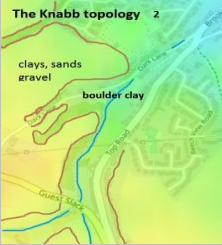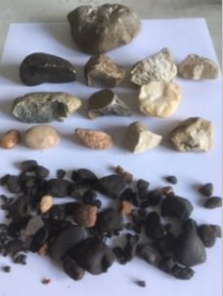Please contact This email address is being protected from spambots. You need JavaScript enabled to view it. if you have any questions or further info to add.
The Knabb stream and the last Ice Age
February 2021
What epic story belies this tranquil setting, with its tree-lined, fast flowing stream? It is an event dating back at least 10,000 years. A time when great tongues of glaciers covered most of Britain. It is hard to imagine it was some 1000m thick in the far arctic north. This was the latest of several Ice Ages, each often lasting millions of years. Beneath, in and on the ice, rocks were being carried mainly from Ireland and the Lake District southwards. These glaciers moved across Cheshire but not always as a continuous ice sheet. Enormous masses of frozen soil and broken rocks were left behind as the glaciers retreated.
Today the Knabb shows the outcome of this glacial deposition with the high ground either side of the stream valley covered with a layer of clay, sands and gravels of varying thickness. In the valley itself, boulder clay, loaded with a mixture of rocks, alien to the area, covered the valley floor.

The simplified map above is taken from the drift geology map (below) of the area, where drift lies on top of the sandstone bedrock; the stream has been added. This 'topsoil' can be many feet thick or a matter of only a few spades depth. The spread of the boulder clay also appears south of Guest Slack and Norley road. Here, the stream continues through marshy ground with almost no discernible banks.

How the valley was formed and whether a river or stream flowed there thousands of years ago, is supposition. A tongue of ice might have occupied the valley, releasing a considerable flow of water as it melted, washing moraine deposits of rocks, sand, gravels and other material into the Knabb valley
Any watercourse moving through the boulder clay would have struggled. A sure sign of this are meanders. Over centuries what may have been a river, carried away the boulder clay leaving its constituent rocks. Today, these rocks, of all shapes and sizes, including pieces of pottery, clay pipes and other debris, cover the sandstone bedrock.
Sampling the stream bed produced an interesting range of rocks, totally absent in Cheshire, apart from sandstone.

All the larger fragments are mainly igneous and metamorphic, formed during volcanic and earth movements, many millions of years ago. For the purists, granite, basalt, quartz, diorite, sandstone was present. A good many smaller, pieces had a black coating. which according to a local geologist, is an algal deposit or some natural trace element entering the stream.
It was suggested to me, that the stream caused these rocks to move downstream when it was flowing at bank high levels. This is true for those smaller rocks covered black all over, showing they have been turned, whereas the large ones stayed put with any algae, if at all, on the upper side.
A third of the course of the stream, below the steps, is natural with the path being its unnatural bank. The far bank shows none of the embanking apparent back to Guest Slack. Here, water thunders out of a large, land drainpipe, powerful enough to move large rocks downstream; yet to be tested
This is the intriguing part of the valley. So many questions come to mind. Why was the stream culverted? Was there once a waterfall? Is there a relationship between here and the 1845 lane? Are the large pools nearby connected? And so on. Interpreting this mystery could open another in its history.
